News
2023/5/16
Kao Develops Practicable Technology for Film-to-Film Recycling of Used Refill Packs
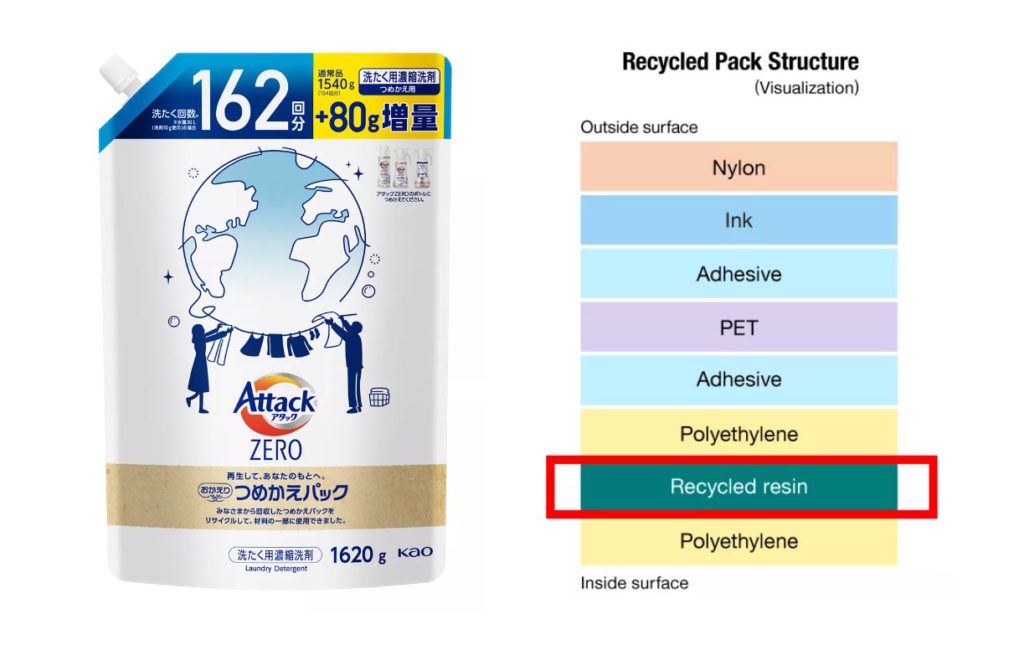
Kao Corporation has developed a product making partial use of recycled materials to produce the same type of packaging by recycling used refill packs, employing technology the company developed for film-to-film recycling making use of that material. Refill packs (1,620g) of Kao’s Attack ZERO using the newly-developed recycled material will go on sale in limited quantities at selected stores*1 , with gradual introduction starting on May 29, 2023. Kao is the world’s first company to use film-to-film recycling technology*2 to transform used refill packs*3 collected from the public and other sources into new refill packs.
- *1 Some Ito-Yokado, Welcia Pharmacy and Aeon stores.
- *2 Removing packs with resin incorporating metallic film from the product stream and recycling into refill packs incorporating metal particles from a metallic overlayer.
- *3 Includes both packs with resin incorporating metallic film and packs with resin incorporating a metallic overlayer.
Background
In April 2019, the Kao Group established its ESG strategy, the Kirei Lifestyle Plan, which outlines 19 leadership actions, one of which is zero waste. To achieve zero waste, Kao promotes Innovation in Reduction and Innovation in Recycling CO2 emissions, with the goal of creating a circular economy for plastic packaging.
Actions that Kao has taken so far to reduce the quantity of plastic it uses for containers include making products more highly concentrated to reduce package size and developing and promoting the use of refill and replacement products. Kao also promoted recycling, assuming responsibility for the entire product life cycle through to disposal. In addition, Kao has field-tested collection of used refill packs in cooperation with local governments, enterprises and retailers to establish a sustainable collection system and develop recycling technologies. Kao views its achievement of developing film-to-film recycling to reuse material from used refill packs as a major step toward encouraging consumers to be more aware of the need to recycle.
The Road to Recycling Used Refill Packs
Film packaging (measuring approx. 100–250μm) for refill packs is a composite of several thin layers of different materials. Similarly to primary containers, it is designed to protect pack content from temperature, humidity and UV rays. This is why refill packs use a multi-layer construction consisting mainly of polyethylene (approx. 80%) and several other materials, including polyethylene terephthalate (PET) and polyamides (nylon). Refill packs for some products may also incorporate metallic film, usually aluminum foil; thus, the composition of refill packs on the market varies widely. But while such packs, which combine different functional materials, use less resin to make, it was commonly believed that developing film-to-film recycling technology would be difficult because of the use of ink for printing pack exteriors, in addition to the various materials in the film. Kao, working with local governments, enterprises, retailers and consumers, began collecting used refill packs in 2016 and developing film-to-film recycling technology. In 2021, the company set up a pilot plant at its Wakayama Research Laboratories to work on developing and testing recycling of its film packaging.
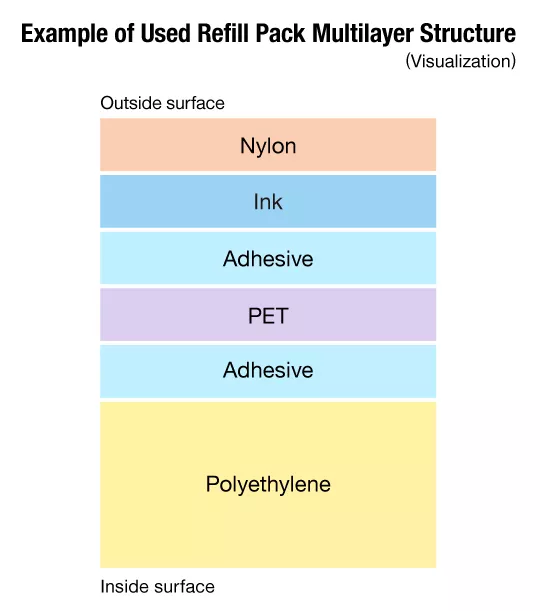
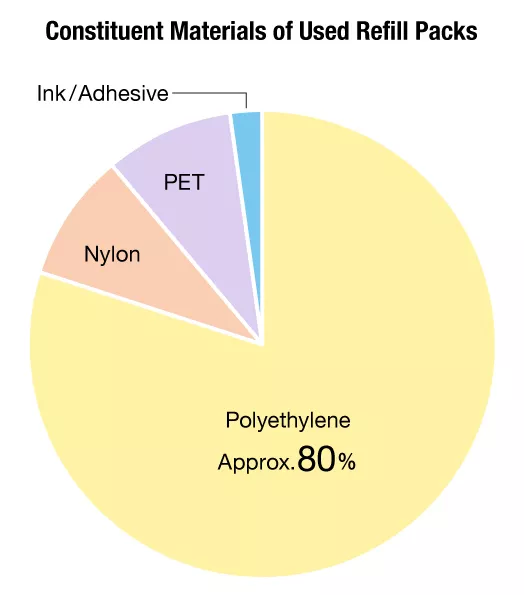
To recycle refill packs, Kao focused on utilizing the properties of polyethylene, which makes up about 80% of the composition of refill packs, which meant reducing impurities coming from PET, nylon, aluminum foil and ink. Initially, when researchers tried to make new film from used refill packs, aluminum foil, ink and other foreign matter stayed in the mix due to insufficient pulverization, and holes developed in the resulting film (see photos).
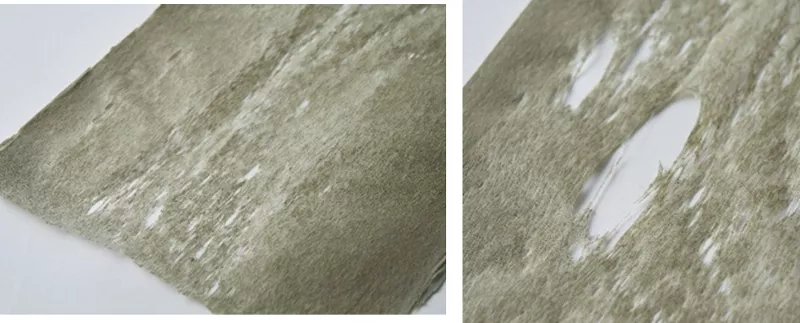
They decided to remove refill packs incorporating aluminum foil from the product stream at the sorting stage. This helped cut down on foreign matter during the recycling process and produce homogeneous film. A compatibilizing agent was also added to aid mixing and dispersal of polyethylene, PET, nylon and other materials, which do not readily mix well, so that smooth film without holes could be produced. Ink and adhesive were also pulverized to prevent holes from forming when the film was made. But when pack surfaces were printed in the final stages of production, it was discovered that the packs felt a bit rough. This was judged to detract from the product’s appearance and function, meaning further research and development.
Employing the Recycling Technology for Refill Packs for the Final Product
Perfectly smooth film was needed to make recycled film into a viable product and ensure that the packaging would function properly and look attractive. Researchers discovered that the uneven texture came from PET, nylon and other substances in the material, which clumped and enlarged during the mixing process, creating foreign matter. New recycling technology for refill packs was then developed to eliminate surface roughness caused by clumping.
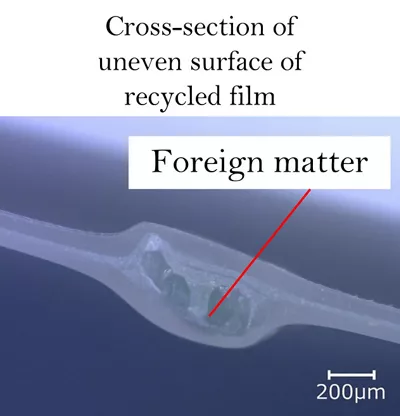

Recycling Technology for Refill Packs
- Filter foreign matter out with a laser filter
Using a laser filter under special conditions during kneading made it possible to physically remove PET and nylon foreign matter. - Further refinement by adding a compatibilizing agent to prevent clumping
PET or nylon left behind after using a laser filter can clump during the mixing process, generating foreign matter. Using a different compatibilizing agent to help PET and nylon mix with polyethylene prevents clumping and suppresses formation of foreign matter, a process developed jointly with Tosoh Corporation. - Temperature optimization during the film-making process
Polyethylene, PET and nylon, the main materials used for film refill packs, each have different melting temperatures. Too high a temperature can damage the properties of the polyethylene. On the other hand, impurities such as PET, nylon and other materials will not melt adequately if the temperature is too low, leading to large clumps and creating foreign matter which causes unevenness. With the new technology, developed jointly with Fuji Seal, Inc., temperature is optimized, allowing the material’s properties to be retained and suppressing clumping.
Kao will also work with Mitsui Chemicals, Inc. and Prime Polymer Co., Ltd. as it explores the best ways of mass-producing recycled resin pellets, the raw material for the recycled film, in the future.
Thanks to this technology, refill packs (1,620g) of Kao’s Attack ZERO that will be launched gradually starting May 29, 2023 contain 10% recycled material, with around 1% of the material coming from used refill packs collected and the remaining 9% from refill packs manufactured but ultimately unused. The recycled material forms one of the middle layers of the packaging (see illustration on right), allowing it to perform its principal function of protecting content quality while also ensuring that the packaging has the required rigidity.
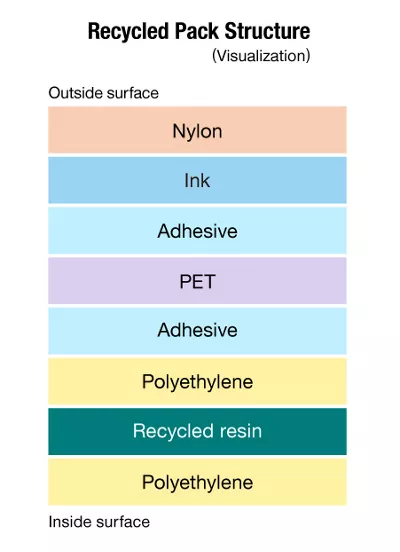
This newly developed recycling technology has made it possible to use film recycled from used refill packs in product packaging, which was previously difficult to achieve. While only limited quantities of the product using this packaging will be available initially, Kao hopes to put more of it on the market, with the goal of putting into practical use and launching products of innovative film-based packaging made from collected refill packs by 2025. In future, Kao will work on designing packaging made from a single material to facilitate recycling and assess different recycling technologies. The company also intends to disseminate its technology within the consumer products industry to promote recycling as widely as possible across the industry and the public. At the same time, to achieve social implementation Kao will work on devising a system for increasing the quantity of used refill packs collected and reduce the cost of making recycled film.
About the Kirei Lifestyle Plan
Over the past 130 years, Kao has worked to improve people’s lives and help them realize more sustainable lifestyles—a Kirei Lifestyle. The Japanese word ‘kirei’ describes something that is clean, well-ordered and beautiful, all at the same time. The Kao Group established its ESG strategy, the Kirei Lifestyle Plan in April 2019, which is designed to deliver the vision of a gentler and more sustainable way of living. By 2030, Kao aims to empower at least 1 billion people, to enjoy more beautiful lives and have 100% of its products leave a full lifecycle environmental footprint that science says our natural world can safely absorb. For more information, please click here.
- Category
- Headline News
- Packaging

